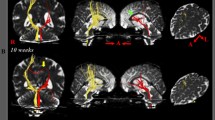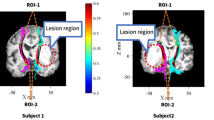Abstract
We assessed the state of the thalamocortical connection between the mediodorsal nucleus (MD) and the dorsolateral prefrontal cortex (DLPFC) in patients with corona radiata infarct using diffusion tensor tractography (DTT). Altogether, 110 patients with corona radiata infarct were recruited, all of whom underwent DTT at an early stage following infarct onset. Based on the integrity of CST (CST+: CST was preserved around the infarct, CST−: CST was interrupted by the infarct) and the integrity of thalamocortical connection between the MD of thalamus and the DLPFC (DLPFC+: the connection was preserved, DLPFC−: the connection was interrupted), patients were divided into 4 groups: CST+/DLPFC+ (37 patients), CST+/DLPFC− (21 patients), CST−/DLPFC+ (25 patients), and CST−/DLPFC− (27 patients) groups. Motor function was evaluated using the upper Motricity Index (MI), lower MI, modified Brunnstrom classification, and the functional ambulation category at baseline and at 6 months post-onset. In patients with preserved CST integrity, the status of the thalamocortical connection had no impact on the assessed motor outcomes at 6 months post-stroke. However, in patients with disrupted CST integrity, those with preserved thalamocortical connection integrity had significantly higher motor function scores in all assessed outcomes 6 months post-stroke than those with disrupted thalamocortical connection integrity. The preservation or disruption of the thalamocortical connection between the MD of the thalamus and the DLPFC is an important factor for motor function recovery when CST integrity is also disrupted.


Similar content being viewed by others

References
Funahashi S (2000) Prefrontal cortex and working memory processes. Neuroscience 289:591–594
Jang SH, Yeo SS (2014) Thalamocortical connections between the mediodorsal nucleus of the thalamus and prefrontal cortex in the human brain: a diffusion tensor tractographic study. Yonsei Med J 55:709–714
Szczepanski SM, Knight RT (2014) Insights into human behavior from lesions to the prefrontal cortex. Neuron 83:1002–1018
Golkar A, Lonsdorf TB, Olsson A, Lindstrom KM, Berrebi J, Fransson P, Schalling M, Ingvar M, Öhman A (2012) Distinct contributions of the dorsolateral prefrontal and orbitofrontal cortex during emotion regulation. PLoS ONE 7:e48107
Gu SY, Chang MC (2017) The Effects of 10-Hz Repetitive transcranial magnetic stimulation on depression in chronic stroke patients. Brain Stimul 10:270–274
Barbey AK, Koenigs M, Grafman J (2013) Dorsolateral prefrontal contributions to human working memory. Cortex 49:1195–1205
Grimm S, Beck J, Schuepbach D, Hell D, Boesiger P, Bermpohl F, Niehaus L, Boeker H, Northoff G (2008) Imbalance between left and right dorsolateral prefrontal cortex in major depression is linked to negative emotional judgment: an fMRI study in severe major depressive disorder. Biol Psychiatry 63:369–376
Kübel S, Stegmayer K, Vanbellingen T, Pastore-Wapp M, Bertschi M, Burgunder JM, Abela E, Weder B, Walther S, Bohlhalter S (2017) Altered praxis network underlying limb kinetic apraxia in Parkinson's disease - an fMRI study. Neuroimage Clin 16:88–97
Zhu Y, Yang D, Ji W, Huang T, Xue L, Jiang X, Chen L, Wang F (2016) The relationship between neurocircuitry dysfunctions and attention deficit hyperactivity disorder: a review. Biomed Res Int 2016:3821579
Mead GE, Legg L, Tilney R, Hsieh CF, Wu S, Lundström E, Rudberg AS, Kutlubaev M, Dennis MS, Soleimani B, Barugh A, Hackett ML, Hankey GJ (2019) Fluoxetine for stroke recovery: meta-analysis of randomized controlled trials. Int J Stroke 17:1747493019879655
Sun JH, Tan L, Yu JT (2014) Post-stroke cognitive impairment: epidemiology, mechanisms and management. Ann Transl Med 2:80
Jang SH, Kim SH, Yeo SS (2018) Injury of thalamocortical connection between the mediodorsal nucleus of the thalamus and the orbitofrontal cortex in a patient with traumatic brain injury. Neural Regen Res 13:1118–1120
Chang MC, Do KH, Chun MH (2015) Prediction of lower limb motor outcomes based on transcranial magnetic stimulation findings in patients with an infarct of the anterior cerebral artery. Somatosens Mot Res 32:249–253
Moon JS, Chung SM, Jang SH, Won KC, Chang MC (2019) Effects of diabetes on motor recovery after cerebral infarct: a diffusion tensor imaging study. J Clin Endocrinol Metab. 104(9):3851–3858
Demeurisse G, Demol O, Robaye E (1980) Motor evaluation in vascular hemiplegia. Eur Neurol 19:382–389
Brunnstrom S (1996) Motor testing procedures in hemiplegia: based on sequential recovery stages. Phys Ther 46:357
Fujii Y, Nakada T (2003) Cortical reorganization in patients with subcortical hemiparesis: neural mechanisms of functional recovery and prognostic implication. J Neurosurg 98:64–73
Cunha IT, Lim PA, Henson H (2002) Performance-based gait tests for acute stroke patients. Am J Phys Med Rehabil 81:848–856
Cho SH, Kim DG, Kim DS, Kim YH, Lee CH, Jang SH (2007) Motor outcome according to the integrity of the corticospinal tract determined by diffusion tensor tractography in the early stage of corona radiata infarct. Neurosci Lett 426:123–127
Jang SH, Bai D, Son SM, Lee J, Kim DS, Sakong J, Kim DG, Yang DS (2008) Motor outcome prediction using diffusion tensor tractography in pontine infarct. Ann Neurol 64:460–465
Jang SH, Choi BY, Chang CH, Kim SH, Chang MC (2013) Prediction of motor outcome based on diffusion tensor tractography findings in thalamic hemorrhage. Int J Neurosci 123:233–239
Jang SH, Jang WH (2016) Ideomotor apraxia due to injury of the superior longitudinal fasciculus. Am J Phys Med Rehabil 95:e117–e120
Jang SH, Kwon YH (2018) Abulia due to injury of the prefrontocaudate tract in a stroke patient. Am J Phys Med Rehabil 97:e76–e77
Funding
The present study was supported by a National Research Foundation of Korea grant funded by the Korean government (Grain No. NRF-2019R1F1A1061348).
Author information
Authors and Affiliations
Contributions
KTC contributed with: concept and design, analysis and interpretation of data, and drafting of the manuscript. CMC contributed with: analysis and interpretation of data, and drafting of the manuscript, and revision of the manuscript.
Corresponding author
Ethics declarations
Ethical approval
All procedures performed in studies involving human participants were in accordance with the ethical standards of the institutional and/or national research committee and with the 1964 Helsinki declaration and its later amendments or comparable ethical standards.
Conflict of interest
The authors declare they have no conflict of interest.
Informed consent
Written informed consent was obtained from all individual participants included in the study.
Additional information
Publisher's Note
Springer Nature remains neutral with regard to jurisdictional claims in published maps and institutional affiliations.
Rights and permissions
About this article
Cite this article
Choi, K.T., Kwak, S.G. & Chang, M.C. Does injury of the thalamocortical connection between the mediodorsal nucleus of the thalamus and the dorsolateral prefrontal cortex affect motor recovery after cerebral infarct?. Acta Neurol Belg 121, 921–926 (2021). https://doi.org/10.1007/s13760-020-01309-2
Received:
Accepted:
Published:
Issue Date:
DOI: https://doi.org/10.1007/s13760-020-01309-2



